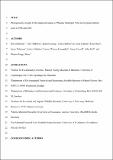Files in this item
Phylogenomic insights to the origin and spread of phocine distemper virus in European harbour seals in 1988 and 2002
Item metadata
| dc.contributor.author | Stokholm, Iben | |
| dc.contributor.author | Härkönen, Tero | |
| dc.contributor.author | Harding, Karin C. | |
| dc.contributor.author | Siebert, Ursula | |
| dc.contributor.author | Lehnert, Kristina | |
| dc.contributor.author | Dietz, Rune | |
| dc.contributor.author | Teilmann, Jonas | |
| dc.contributor.author | Galatius, Anders | |
| dc.contributor.author | Havmøller, Linnea Worsøe | |
| dc.contributor.author | Carroll, Emma L. | |
| dc.contributor.author | Hall, Ailsa | |
| dc.contributor.author | Olsen, Morten Tange | |
| dc.date.accessioned | 2020-02-21T00:34:54Z | |
| dc.date.available | 2020-02-21T00:34:54Z | |
| dc.date.issued | 2019-02-21 | |
| dc.identifier | 258965270 | |
| dc.identifier | 3e3fa66c-0d9e-4030-8890-1ea8da781c5c | |
| dc.identifier | 85064695144 | |
| dc.identifier | 000483878800006 | |
| dc.identifier.citation | Stokholm , I , Härkönen , T , Harding , K C , Siebert , U , Lehnert , K , Dietz , R , Teilmann , J , Galatius , A , Havmøller , L W , Carroll , E L , Hall , A & Olsen , M T 2019 , ' Phylogenomic insights to the origin and spread of phocine distemper virus in European harbour seals in 1988 and 2002 ' , Diseases of Aquatic Organisms , vol. 133 , no. 1 , pp. 47-56 . https://doi.org/10.3354/dao03328 | en |
| dc.identifier.issn | 0177-5103 | |
| dc.identifier.other | ORCID: /0000-0002-7562-1771/work/57568152 | |
| dc.identifier.uri | https://hdl.handle.net/10023/19511 | |
| dc.description | The study was supported by the Villum Foundation, the Danish Ministry of the Environment, the Volkswagen Foundation (Az.: 89911) and the BONUS programme BaltHealth, which has received funding from BONUS (Art. 185), funded jointly by the EU, Innovation Fund Denmark (grants 6180-00001B and 6180-00002B), Forschungszentrum Jülich GmbH, German Federal Ministry of Education and Research (grant FKZ 03F0767A), Academy of Finland (grant 311966) and Swedish Foundation for Strategic Environmental Research (MISTRA). | en |
| dc.description.abstract | The 1988 and 2002 phocine distemper virus (PDV) outbreaks in European harbour seals Phoca vitulina are among the largest mass mortality events recorded in marine mammals. Despite its large impact on harbour seal population numbers, and 3 decades of studies, many questions regarding the spread and temporal origin of PDV remain unanswered. Here, we sequenced and analysed 7123 bp of the PDV genome, including the coding and non-coding regions of the entire P, M, F and H genes in tissues from 44 harbour seals to shed new light on the origin and spread of PDV in 1988 and 2002. The phylogenetic analyses trace the origin of the PDV strain causing the 1988 outbreak to between June 1987 and April 1988, while the origin of the strain causing the 2002 outbreak can be traced back to between July 2001 and April 2002. The analyses further point to several independent introductions of PDV in 1988, possibly linked to a southward mass immigration of harp seals in the winter and spring of 1987−1988. The vector for the 2002 outbreak is unknown, but the epidemiological analyses suggest the subsequent spread of PDV from the epicentre in the Kattegat, Denmark, to haul-out sites in the North Sea through several independent introductions. | |
| dc.format.extent | 10 | |
| dc.format.extent | 942074 | |
| dc.language.iso | eng | |
| dc.relation.ispartof | Diseases of Aquatic Organisms | en |
| dc.subject | Epidemic | en |
| dc.subject | Morbillivirus | en |
| dc.subject | Viral phylogeny | en |
| dc.subject | Virus evolution | en |
| dc.subject | Wildlife pathogen | en |
| dc.subject | GC Oceanography | en |
| dc.subject | QH301 Biology | en |
| dc.subject | Ecology, Evolution, Behavior and Systematics | en |
| dc.subject | Aquatic Science | en |
| dc.subject | NDAS | en |
| dc.subject | SDG 10 - Reduced Inequalities | en |
| dc.subject | SDG 14 - Life Below Water | en |
| dc.subject.lcc | GC | en |
| dc.subject.lcc | QH301 | en |
| dc.title | Phylogenomic insights to the origin and spread of phocine distemper virus in European harbour seals in 1988 and 2002 | en |
| dc.type | Journal article | en |
| dc.contributor.institution | University of St Andrews. School of Biology | en |
| dc.contributor.institution | University of St Andrews. Sea Mammal Research Unit | en |
| dc.contributor.institution | University of St Andrews. Marine Alliance for Science & Technology Scotland | en |
| dc.contributor.institution | University of St Andrews. Scottish Oceans Institute | en |
| dc.identifier.doi | https://doi.org/10.3354/dao03328 | |
| dc.description.status | Peer reviewed | en |
| dc.date.embargoedUntil | 2020-02-21 |
This item appears in the following Collection(s)
Items in the St Andrews Research Repository are protected by copyright, with all rights reserved, unless otherwise indicated.

